Food Policy Assignment PDF
VerifiedAdded on 2021/05/31
|11
|2812
|26
AI Summary
Contribute Materials
Your contribution can guide someone’s learning journey. Share your
documents today.
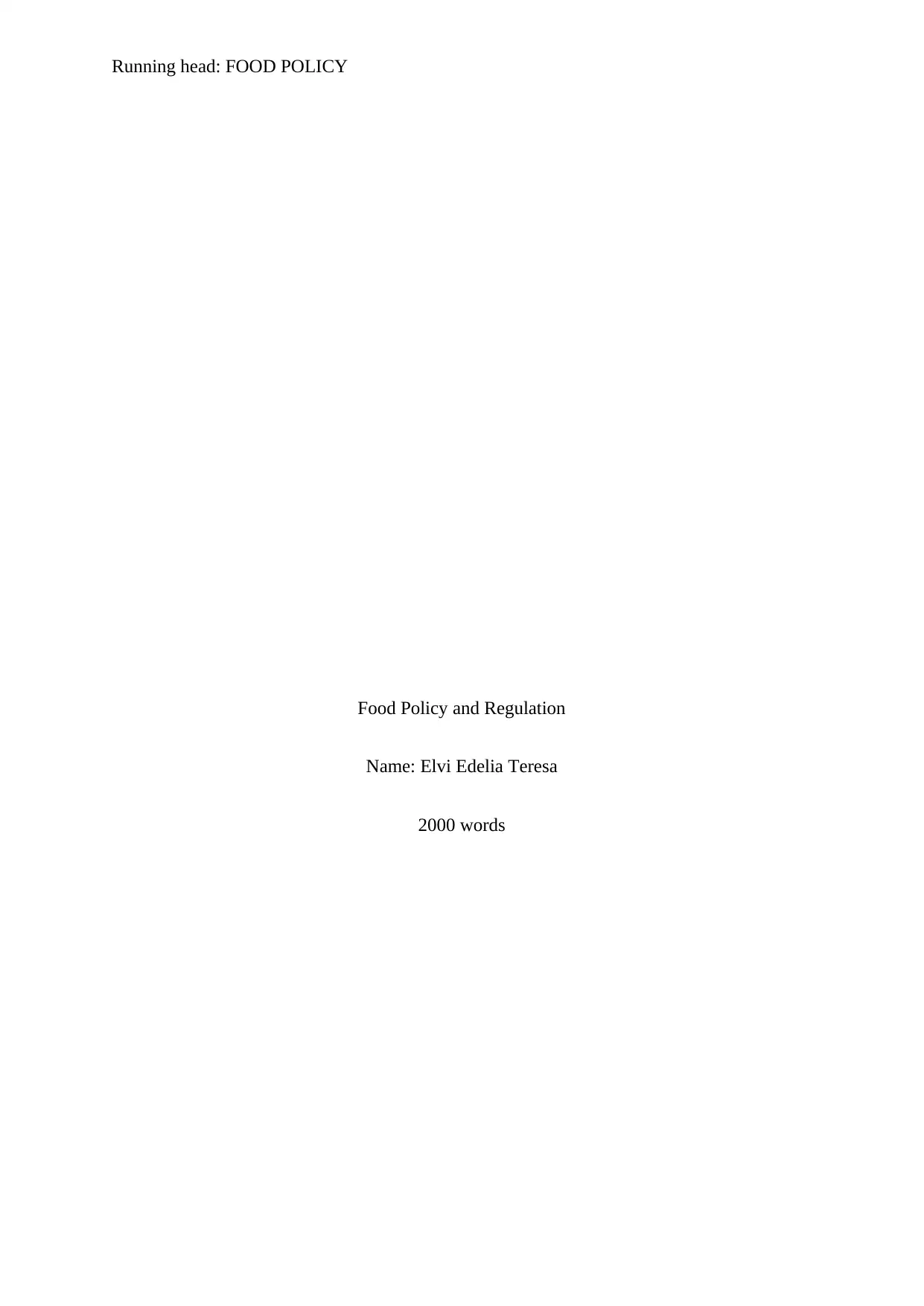
Running head: FOOD POLICY
Food Policy and Regulation
Name: Elvi Edelia Teresa
2000 words
Food Policy and Regulation
Name: Elvi Edelia Teresa
2000 words
Secure Best Marks with AI Grader
Need help grading? Try our AI Grader for instant feedback on your assignments.
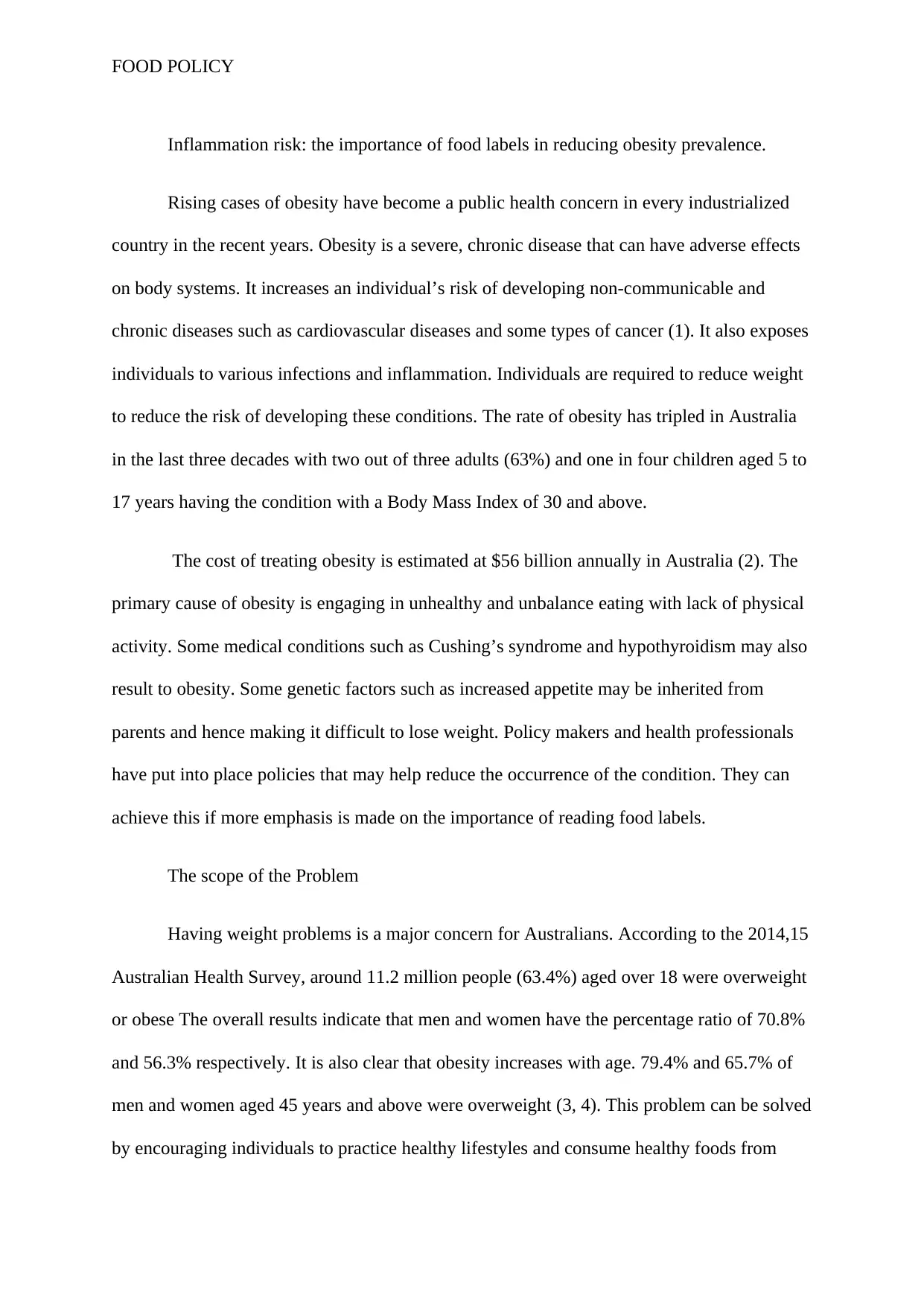
FOOD POLICY
Inflammation risk: the importance of food labels in reducing obesity prevalence.
Rising cases of obesity have become a public health concern in every industrialized
country in the recent years. Obesity is a severe, chronic disease that can have adverse effects
on body systems. It increases an individual’s risk of developing non-communicable and
chronic diseases such as cardiovascular diseases and some types of cancer (1). It also exposes
individuals to various infections and inflammation. Individuals are required to reduce weight
to reduce the risk of developing these conditions. The rate of obesity has tripled in Australia
in the last three decades with two out of three adults (63%) and one in four children aged 5 to
17 years having the condition with a Body Mass Index of 30 and above.
The cost of treating obesity is estimated at $56 billion annually in Australia (2). The
primary cause of obesity is engaging in unhealthy and unbalance eating with lack of physical
activity. Some medical conditions such as Cushing’s syndrome and hypothyroidism may also
result to obesity. Some genetic factors such as increased appetite may be inherited from
parents and hence making it difficult to lose weight. Policy makers and health professionals
have put into place policies that may help reduce the occurrence of the condition. They can
achieve this if more emphasis is made on the importance of reading food labels.
The scope of the Problem
Having weight problems is a major concern for Australians. According to the 2014,15
Australian Health Survey, around 11.2 million people (63.4%) aged over 18 were overweight
or obese The overall results indicate that men and women have the percentage ratio of 70.8%
and 56.3% respectively. It is also clear that obesity increases with age. 79.4% and 65.7% of
men and women aged 45 years and above were overweight (3, 4). This problem can be solved
by encouraging individuals to practice healthy lifestyles and consume healthy foods from
Inflammation risk: the importance of food labels in reducing obesity prevalence.
Rising cases of obesity have become a public health concern in every industrialized
country in the recent years. Obesity is a severe, chronic disease that can have adverse effects
on body systems. It increases an individual’s risk of developing non-communicable and
chronic diseases such as cardiovascular diseases and some types of cancer (1). It also exposes
individuals to various infections and inflammation. Individuals are required to reduce weight
to reduce the risk of developing these conditions. The rate of obesity has tripled in Australia
in the last three decades with two out of three adults (63%) and one in four children aged 5 to
17 years having the condition with a Body Mass Index of 30 and above.
The cost of treating obesity is estimated at $56 billion annually in Australia (2). The
primary cause of obesity is engaging in unhealthy and unbalance eating with lack of physical
activity. Some medical conditions such as Cushing’s syndrome and hypothyroidism may also
result to obesity. Some genetic factors such as increased appetite may be inherited from
parents and hence making it difficult to lose weight. Policy makers and health professionals
have put into place policies that may help reduce the occurrence of the condition. They can
achieve this if more emphasis is made on the importance of reading food labels.
The scope of the Problem
Having weight problems is a major concern for Australians. According to the 2014,15
Australian Health Survey, around 11.2 million people (63.4%) aged over 18 were overweight
or obese The overall results indicate that men and women have the percentage ratio of 70.8%
and 56.3% respectively. It is also clear that obesity increases with age. 79.4% and 65.7% of
men and women aged 45 years and above were overweight (3, 4). This problem can be solved
by encouraging individuals to practice healthy lifestyles and consume healthy foods from
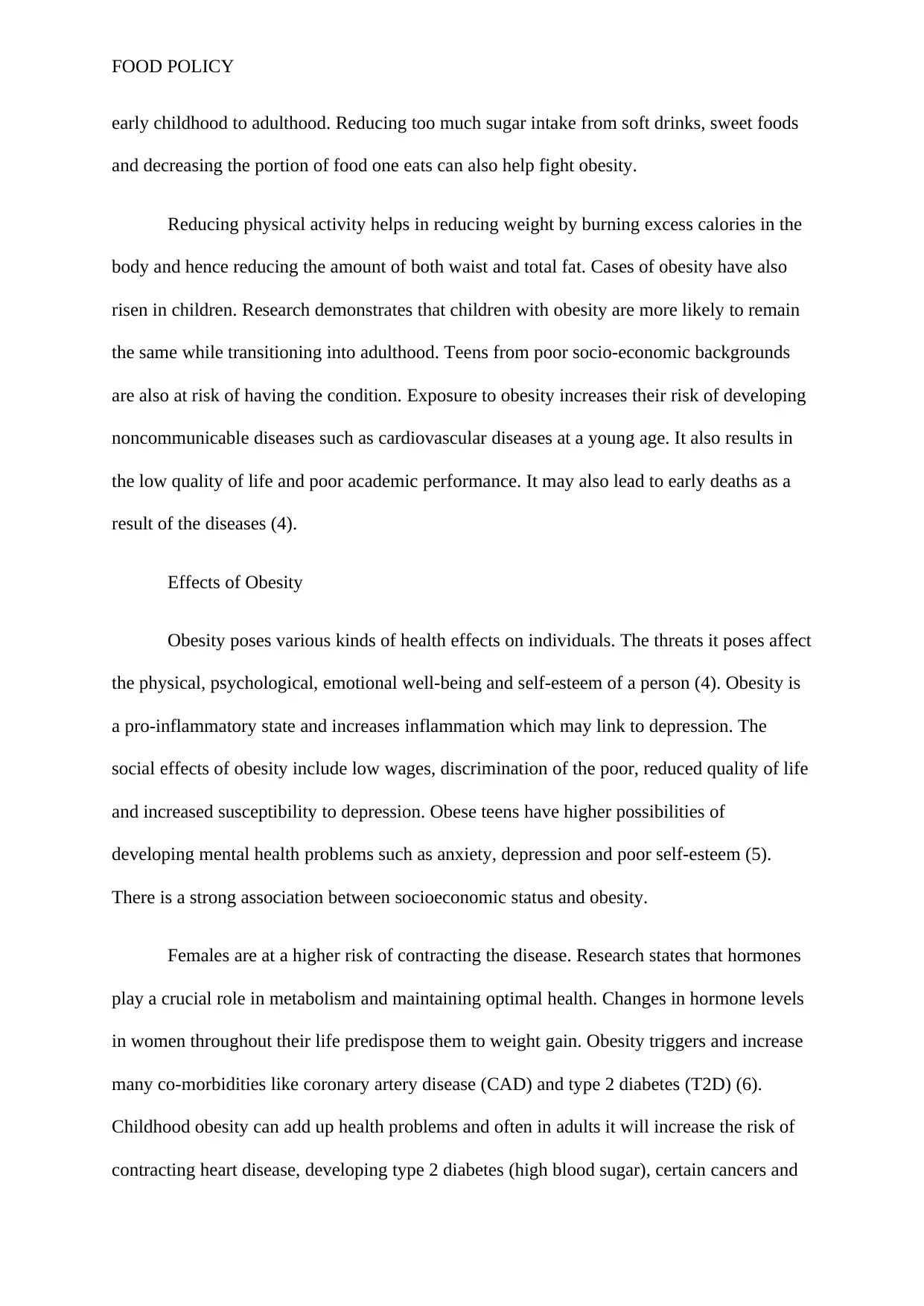
FOOD POLICY
early childhood to adulthood. Reducing too much sugar intake from soft drinks, sweet foods
and decreasing the portion of food one eats can also help fight obesity.
Reducing physical activity helps in reducing weight by burning excess calories in the
body and hence reducing the amount of both waist and total fat. Cases of obesity have also
risen in children. Research demonstrates that children with obesity are more likely to remain
the same while transitioning into adulthood. Teens from poor socio-economic backgrounds
are also at risk of having the condition. Exposure to obesity increases their risk of developing
noncommunicable diseases such as cardiovascular diseases at a young age. It also results in
the low quality of life and poor academic performance. It may also lead to early deaths as a
result of the diseases (4).
Effects of Obesity
Obesity poses various kinds of health effects on individuals. The threats it poses affect
the physical, psychological, emotional well-being and self-esteem of a person (4). Obesity is
a pro-inflammatory state and increases inflammation which may link to depression. The
social effects of obesity include low wages, discrimination of the poor, reduced quality of life
and increased susceptibility to depression. Obese teens have higher possibilities of
developing mental health problems such as anxiety, depression and poor self-esteem (5).
There is a strong association between socioeconomic status and obesity.
Females are at a higher risk of contracting the disease. Research states that hormones
play a crucial role in metabolism and maintaining optimal health. Changes in hormone levels
in women throughout their life predispose them to weight gain. Obesity triggers and increase
many co-morbidities like coronary artery disease (CAD) and type 2 diabetes (T2D) (6).
Childhood obesity can add up health problems and often in adults it will increase the risk of
contracting heart disease, developing type 2 diabetes (high blood sugar), certain cancers and
early childhood to adulthood. Reducing too much sugar intake from soft drinks, sweet foods
and decreasing the portion of food one eats can also help fight obesity.
Reducing physical activity helps in reducing weight by burning excess calories in the
body and hence reducing the amount of both waist and total fat. Cases of obesity have also
risen in children. Research demonstrates that children with obesity are more likely to remain
the same while transitioning into adulthood. Teens from poor socio-economic backgrounds
are also at risk of having the condition. Exposure to obesity increases their risk of developing
noncommunicable diseases such as cardiovascular diseases at a young age. It also results in
the low quality of life and poor academic performance. It may also lead to early deaths as a
result of the diseases (4).
Effects of Obesity
Obesity poses various kinds of health effects on individuals. The threats it poses affect
the physical, psychological, emotional well-being and self-esteem of a person (4). Obesity is
a pro-inflammatory state and increases inflammation which may link to depression. The
social effects of obesity include low wages, discrimination of the poor, reduced quality of life
and increased susceptibility to depression. Obese teens have higher possibilities of
developing mental health problems such as anxiety, depression and poor self-esteem (5).
There is a strong association between socioeconomic status and obesity.
Females are at a higher risk of contracting the disease. Research states that hormones
play a crucial role in metabolism and maintaining optimal health. Changes in hormone levels
in women throughout their life predispose them to weight gain. Obesity triggers and increase
many co-morbidities like coronary artery disease (CAD) and type 2 diabetes (T2D) (6).
Childhood obesity can add up health problems and often in adults it will increase the risk of
contracting heart disease, developing type 2 diabetes (high blood sugar), certain cancers and
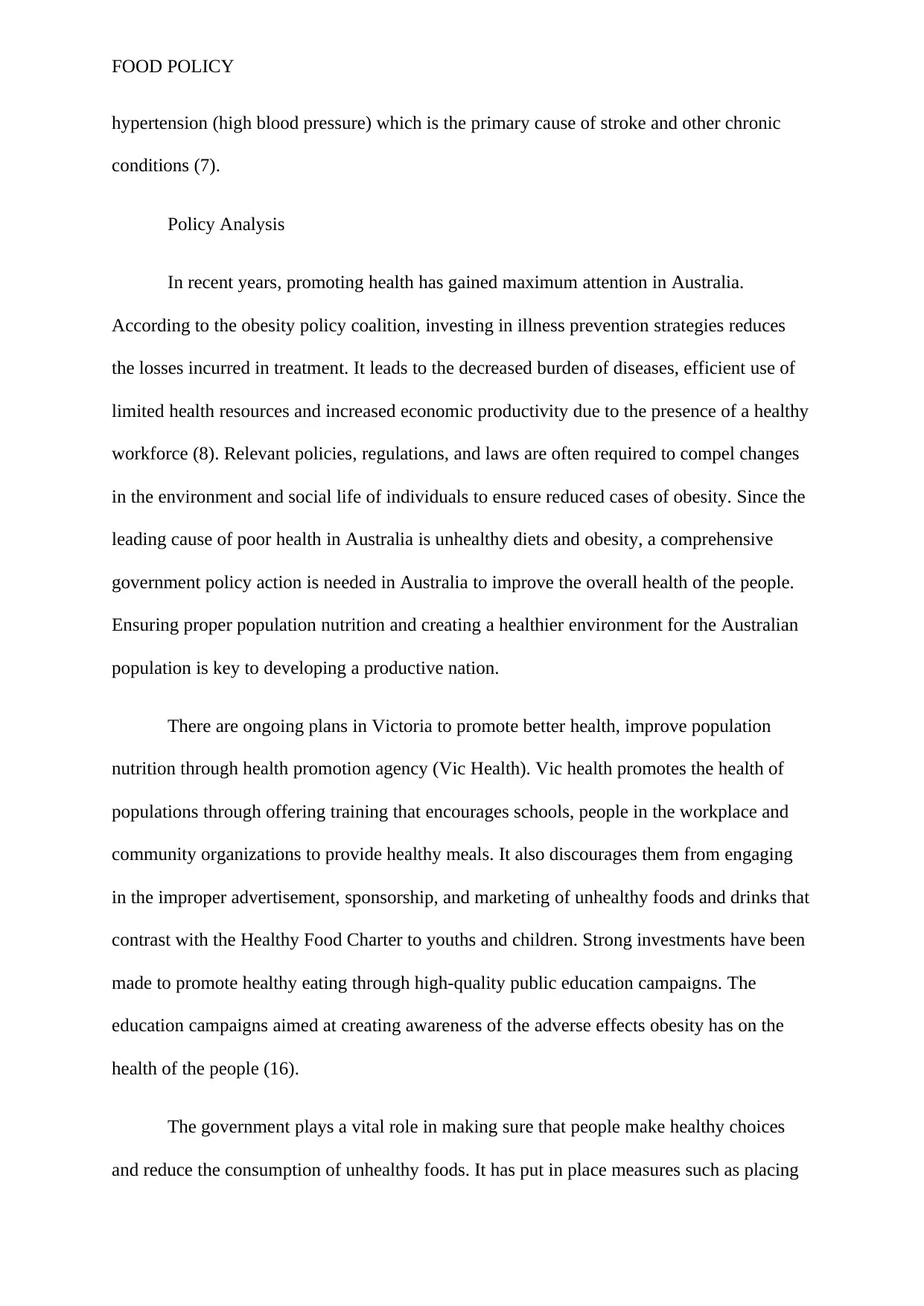
FOOD POLICY
hypertension (high blood pressure) which is the primary cause of stroke and other chronic
conditions (7).
Policy Analysis
In recent years, promoting health has gained maximum attention in Australia.
According to the obesity policy coalition, investing in illness prevention strategies reduces
the losses incurred in treatment. It leads to the decreased burden of diseases, efficient use of
limited health resources and increased economic productivity due to the presence of a healthy
workforce (8). Relevant policies, regulations, and laws are often required to compel changes
in the environment and social life of individuals to ensure reduced cases of obesity. Since the
leading cause of poor health in Australia is unhealthy diets and obesity, a comprehensive
government policy action is needed in Australia to improve the overall health of the people.
Ensuring proper population nutrition and creating a healthier environment for the Australian
population is key to developing a productive nation.
There are ongoing plans in Victoria to promote better health, improve population
nutrition through health promotion agency (Vic Health). Vic health promotes the health of
populations through offering training that encourages schools, people in the workplace and
community organizations to provide healthy meals. It also discourages them from engaging
in the improper advertisement, sponsorship, and marketing of unhealthy foods and drinks that
contrast with the Healthy Food Charter to youths and children. Strong investments have been
made to promote healthy eating through high-quality public education campaigns. The
education campaigns aimed at creating awareness of the adverse effects obesity has on the
health of the people (16).
The government plays a vital role in making sure that people make healthy choices
and reduce the consumption of unhealthy foods. It has put in place measures such as placing
hypertension (high blood pressure) which is the primary cause of stroke and other chronic
conditions (7).
Policy Analysis
In recent years, promoting health has gained maximum attention in Australia.
According to the obesity policy coalition, investing in illness prevention strategies reduces
the losses incurred in treatment. It leads to the decreased burden of diseases, efficient use of
limited health resources and increased economic productivity due to the presence of a healthy
workforce (8). Relevant policies, regulations, and laws are often required to compel changes
in the environment and social life of individuals to ensure reduced cases of obesity. Since the
leading cause of poor health in Australia is unhealthy diets and obesity, a comprehensive
government policy action is needed in Australia to improve the overall health of the people.
Ensuring proper population nutrition and creating a healthier environment for the Australian
population is key to developing a productive nation.
There are ongoing plans in Victoria to promote better health, improve population
nutrition through health promotion agency (Vic Health). Vic health promotes the health of
populations through offering training that encourages schools, people in the workplace and
community organizations to provide healthy meals. It also discourages them from engaging
in the improper advertisement, sponsorship, and marketing of unhealthy foods and drinks that
contrast with the Healthy Food Charter to youths and children. Strong investments have been
made to promote healthy eating through high-quality public education campaigns. The
education campaigns aimed at creating awareness of the adverse effects obesity has on the
health of the people (16).
The government plays a vital role in making sure that people make healthy choices
and reduce the consumption of unhealthy foods. It has put in place measures such as placing
Secure Best Marks with AI Grader
Need help grading? Try our AI Grader for instant feedback on your assignments.
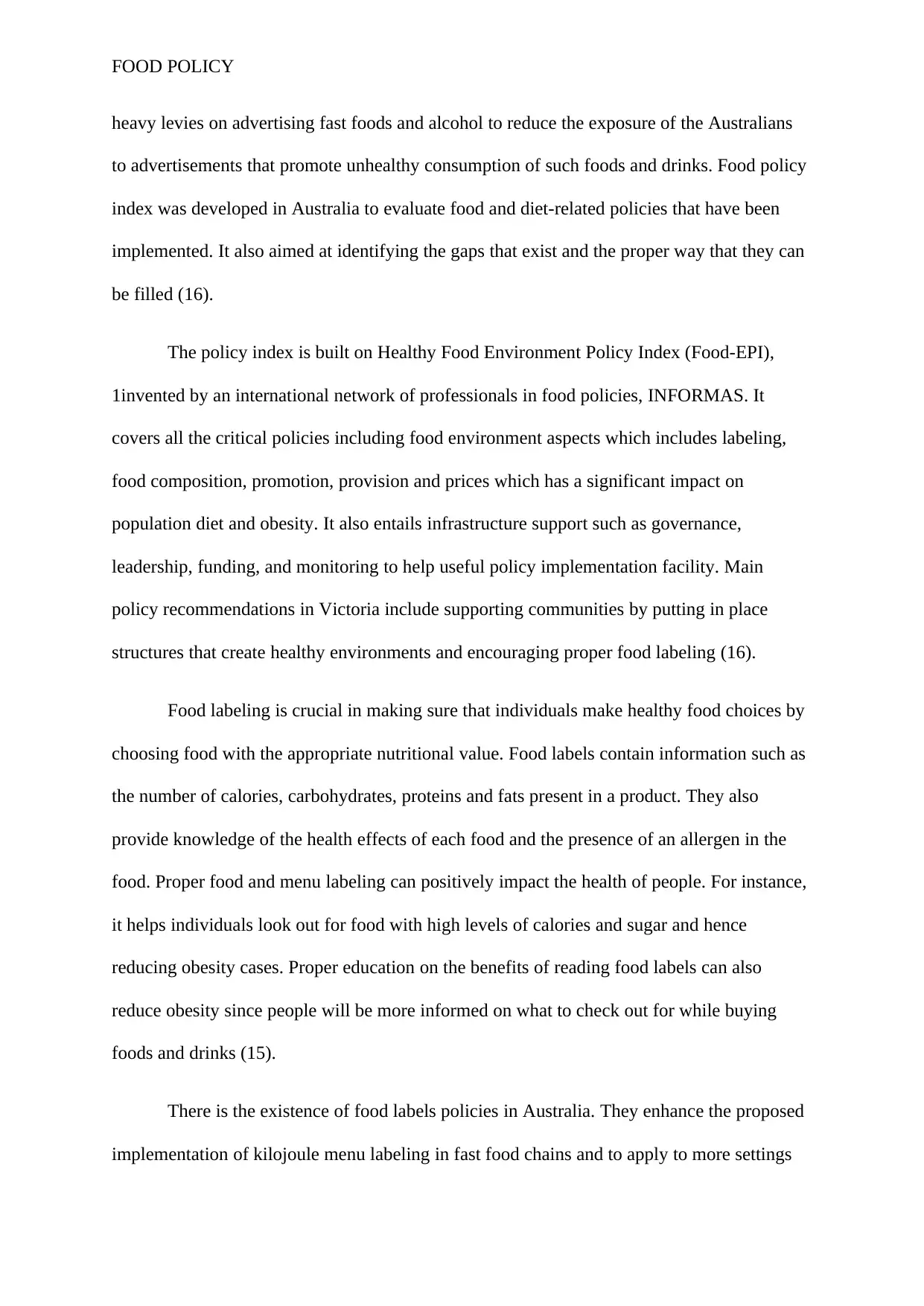
FOOD POLICY
heavy levies on advertising fast foods and alcohol to reduce the exposure of the Australians
to advertisements that promote unhealthy consumption of such foods and drinks. Food policy
index was developed in Australia to evaluate food and diet-related policies that have been
implemented. It also aimed at identifying the gaps that exist and the proper way that they can
be filled (16).
The policy index is built on Healthy Food Environment Policy Index (Food-EPI),
1invented by an international network of professionals in food policies, INFORMAS. It
covers all the critical policies including food environment aspects which includes labeling,
food composition, promotion, provision and prices which has a significant impact on
population diet and obesity. It also entails infrastructure support such as governance,
leadership, funding, and monitoring to help useful policy implementation facility. Main
policy recommendations in Victoria include supporting communities by putting in place
structures that create healthy environments and encouraging proper food labeling (16).
Food labeling is crucial in making sure that individuals make healthy food choices by
choosing food with the appropriate nutritional value. Food labels contain information such as
the number of calories, carbohydrates, proteins and fats present in a product. They also
provide knowledge of the health effects of each food and the presence of an allergen in the
food. Proper food and menu labeling can positively impact the health of people. For instance,
it helps individuals look out for food with high levels of calories and sugar and hence
reducing obesity cases. Proper education on the benefits of reading food labels can also
reduce obesity since people will be more informed on what to check out for while buying
foods and drinks (15).
There is the existence of food labels policies in Australia. They enhance the proposed
implementation of kilojoule menu labeling in fast food chains and to apply to more settings
heavy levies on advertising fast foods and alcohol to reduce the exposure of the Australians
to advertisements that promote unhealthy consumption of such foods and drinks. Food policy
index was developed in Australia to evaluate food and diet-related policies that have been
implemented. It also aimed at identifying the gaps that exist and the proper way that they can
be filled (16).
The policy index is built on Healthy Food Environment Policy Index (Food-EPI),
1invented by an international network of professionals in food policies, INFORMAS. It
covers all the critical policies including food environment aspects which includes labeling,
food composition, promotion, provision and prices which has a significant impact on
population diet and obesity. It also entails infrastructure support such as governance,
leadership, funding, and monitoring to help useful policy implementation facility. Main
policy recommendations in Victoria include supporting communities by putting in place
structures that create healthy environments and encouraging proper food labeling (16).
Food labeling is crucial in making sure that individuals make healthy food choices by
choosing food with the appropriate nutritional value. Food labels contain information such as
the number of calories, carbohydrates, proteins and fats present in a product. They also
provide knowledge of the health effects of each food and the presence of an allergen in the
food. Proper food and menu labeling can positively impact the health of people. For instance,
it helps individuals look out for food with high levels of calories and sugar and hence
reducing obesity cases. Proper education on the benefits of reading food labels can also
reduce obesity since people will be more informed on what to check out for while buying
foods and drinks (15).
There is the existence of food labels policies in Australia. They enhance the proposed
implementation of kilojoule menu labeling in fast food chains and to apply to more settings
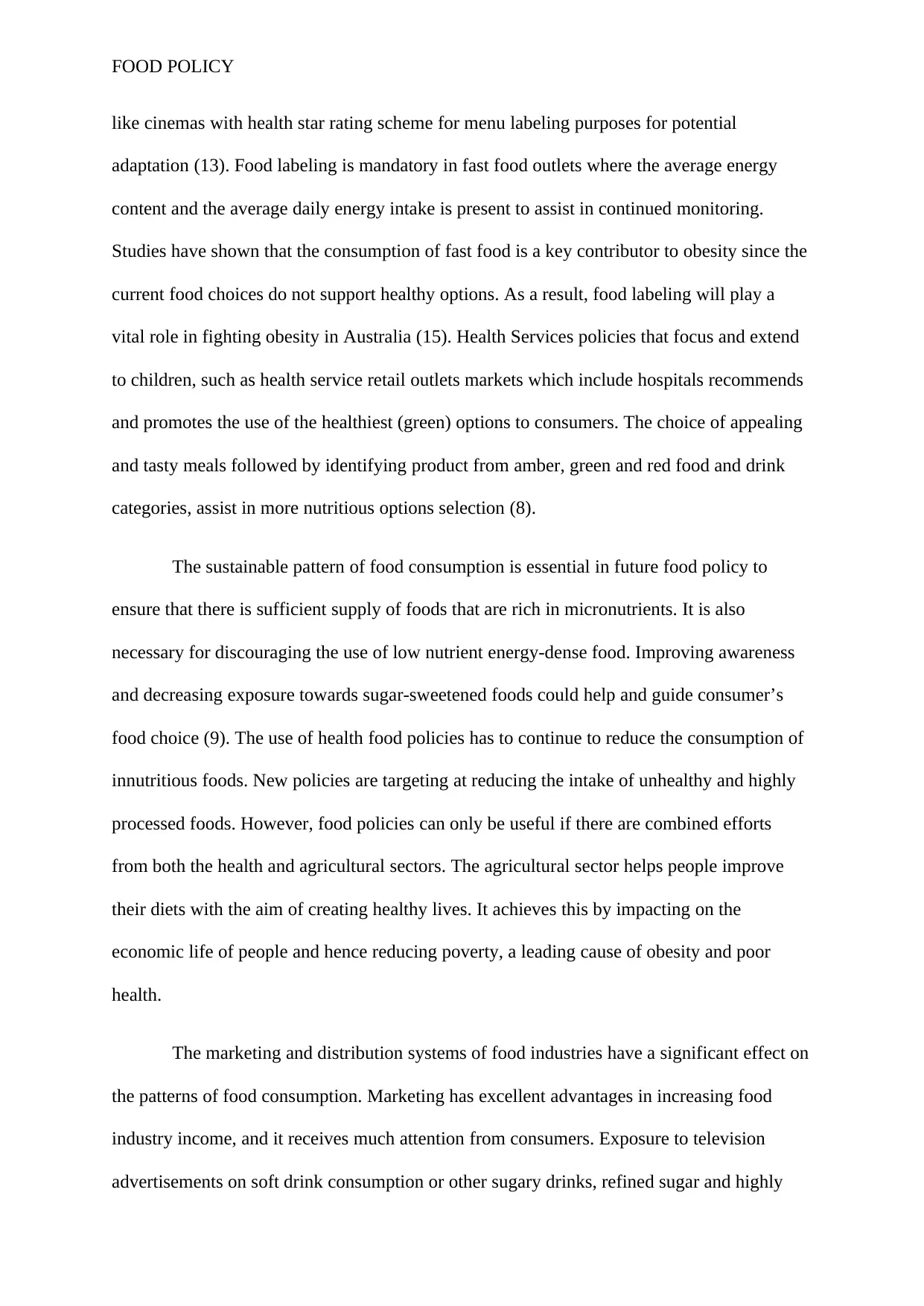
FOOD POLICY
like cinemas with health star rating scheme for menu labeling purposes for potential
adaptation (13). Food labeling is mandatory in fast food outlets where the average energy
content and the average daily energy intake is present to assist in continued monitoring.
Studies have shown that the consumption of fast food is a key contributor to obesity since the
current food choices do not support healthy options. As a result, food labeling will play a
vital role in fighting obesity in Australia (15). Health Services policies that focus and extend
to children, such as health service retail outlets markets which include hospitals recommends
and promotes the use of the healthiest (green) options to consumers. The choice of appealing
and tasty meals followed by identifying product from amber, green and red food and drink
categories, assist in more nutritious options selection (8).
The sustainable pattern of food consumption is essential in future food policy to
ensure that there is sufficient supply of foods that are rich in micronutrients. It is also
necessary for discouraging the use of low nutrient energy-dense food. Improving awareness
and decreasing exposure towards sugar-sweetened foods could help and guide consumer’s
food choice (9). The use of health food policies has to continue to reduce the consumption of
innutritious foods. New policies are targeting at reducing the intake of unhealthy and highly
processed foods. However, food policies can only be useful if there are combined efforts
from both the health and agricultural sectors. The agricultural sector helps people improve
their diets with the aim of creating healthy lives. It achieves this by impacting on the
economic life of people and hence reducing poverty, a leading cause of obesity and poor
health.
The marketing and distribution systems of food industries have a significant effect on
the patterns of food consumption. Marketing has excellent advantages in increasing food
industry income, and it receives much attention from consumers. Exposure to television
advertisements on soft drink consumption or other sugary drinks, refined sugar and highly
like cinemas with health star rating scheme for menu labeling purposes for potential
adaptation (13). Food labeling is mandatory in fast food outlets where the average energy
content and the average daily energy intake is present to assist in continued monitoring.
Studies have shown that the consumption of fast food is a key contributor to obesity since the
current food choices do not support healthy options. As a result, food labeling will play a
vital role in fighting obesity in Australia (15). Health Services policies that focus and extend
to children, such as health service retail outlets markets which include hospitals recommends
and promotes the use of the healthiest (green) options to consumers. The choice of appealing
and tasty meals followed by identifying product from amber, green and red food and drink
categories, assist in more nutritious options selection (8).
The sustainable pattern of food consumption is essential in future food policy to
ensure that there is sufficient supply of foods that are rich in micronutrients. It is also
necessary for discouraging the use of low nutrient energy-dense food. Improving awareness
and decreasing exposure towards sugar-sweetened foods could help and guide consumer’s
food choice (9). The use of health food policies has to continue to reduce the consumption of
innutritious foods. New policies are targeting at reducing the intake of unhealthy and highly
processed foods. However, food policies can only be useful if there are combined efforts
from both the health and agricultural sectors. The agricultural sector helps people improve
their diets with the aim of creating healthy lives. It achieves this by impacting on the
economic life of people and hence reducing poverty, a leading cause of obesity and poor
health.
The marketing and distribution systems of food industries have a significant effect on
the patterns of food consumption. Marketing has excellent advantages in increasing food
industry income, and it receives much attention from consumers. Exposure to television
advertisements on soft drink consumption or other sugary drinks, refined sugar and highly
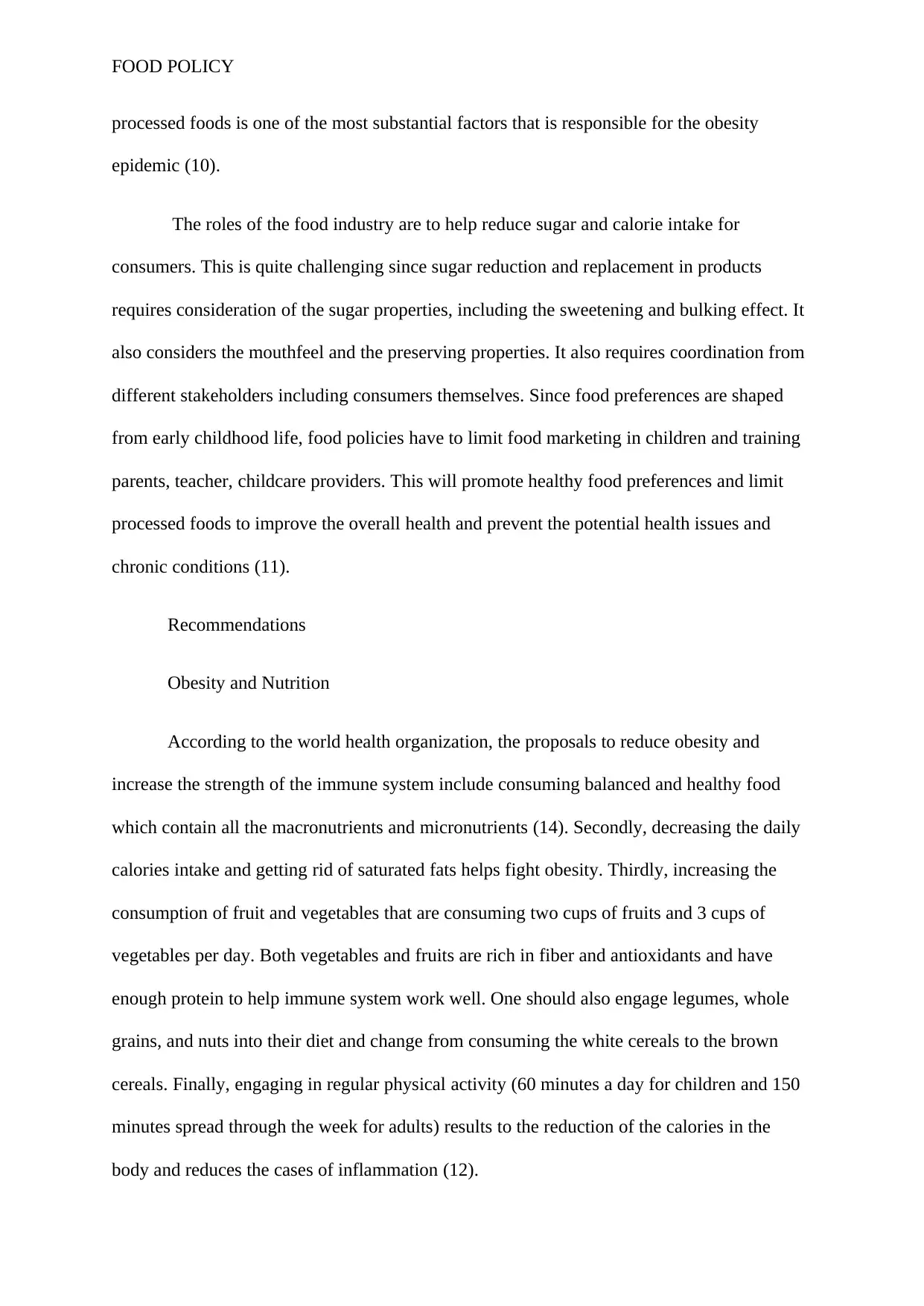
FOOD POLICY
processed foods is one of the most substantial factors that is responsible for the obesity
epidemic (10).
The roles of the food industry are to help reduce sugar and calorie intake for
consumers. This is quite challenging since sugar reduction and replacement in products
requires consideration of the sugar properties, including the sweetening and bulking effect. It
also considers the mouthfeel and the preserving properties. It also requires coordination from
different stakeholders including consumers themselves. Since food preferences are shaped
from early childhood life, food policies have to limit food marketing in children and training
parents, teacher, childcare providers. This will promote healthy food preferences and limit
processed foods to improve the overall health and prevent the potential health issues and
chronic conditions (11).
Recommendations
Obesity and Nutrition
According to the world health organization, the proposals to reduce obesity and
increase the strength of the immune system include consuming balanced and healthy food
which contain all the macronutrients and micronutrients (14). Secondly, decreasing the daily
calories intake and getting rid of saturated fats helps fight obesity. Thirdly, increasing the
consumption of fruit and vegetables that are consuming two cups of fruits and 3 cups of
vegetables per day. Both vegetables and fruits are rich in fiber and antioxidants and have
enough protein to help immune system work well. One should also engage legumes, whole
grains, and nuts into their diet and change from consuming the white cereals to the brown
cereals. Finally, engaging in regular physical activity (60 minutes a day for children and 150
minutes spread through the week for adults) results to the reduction of the calories in the
body and reduces the cases of inflammation (12).
processed foods is one of the most substantial factors that is responsible for the obesity
epidemic (10).
The roles of the food industry are to help reduce sugar and calorie intake for
consumers. This is quite challenging since sugar reduction and replacement in products
requires consideration of the sugar properties, including the sweetening and bulking effect. It
also considers the mouthfeel and the preserving properties. It also requires coordination from
different stakeholders including consumers themselves. Since food preferences are shaped
from early childhood life, food policies have to limit food marketing in children and training
parents, teacher, childcare providers. This will promote healthy food preferences and limit
processed foods to improve the overall health and prevent the potential health issues and
chronic conditions (11).
Recommendations
Obesity and Nutrition
According to the world health organization, the proposals to reduce obesity and
increase the strength of the immune system include consuming balanced and healthy food
which contain all the macronutrients and micronutrients (14). Secondly, decreasing the daily
calories intake and getting rid of saturated fats helps fight obesity. Thirdly, increasing the
consumption of fruit and vegetables that are consuming two cups of fruits and 3 cups of
vegetables per day. Both vegetables and fruits are rich in fiber and antioxidants and have
enough protein to help immune system work well. One should also engage legumes, whole
grains, and nuts into their diet and change from consuming the white cereals to the brown
cereals. Finally, engaging in regular physical activity (60 minutes a day for children and 150
minutes spread through the week for adults) results to the reduction of the calories in the
body and reduces the cases of inflammation (12).
Paraphrase This Document
Need a fresh take? Get an instant paraphrase of this document with our AI Paraphraser
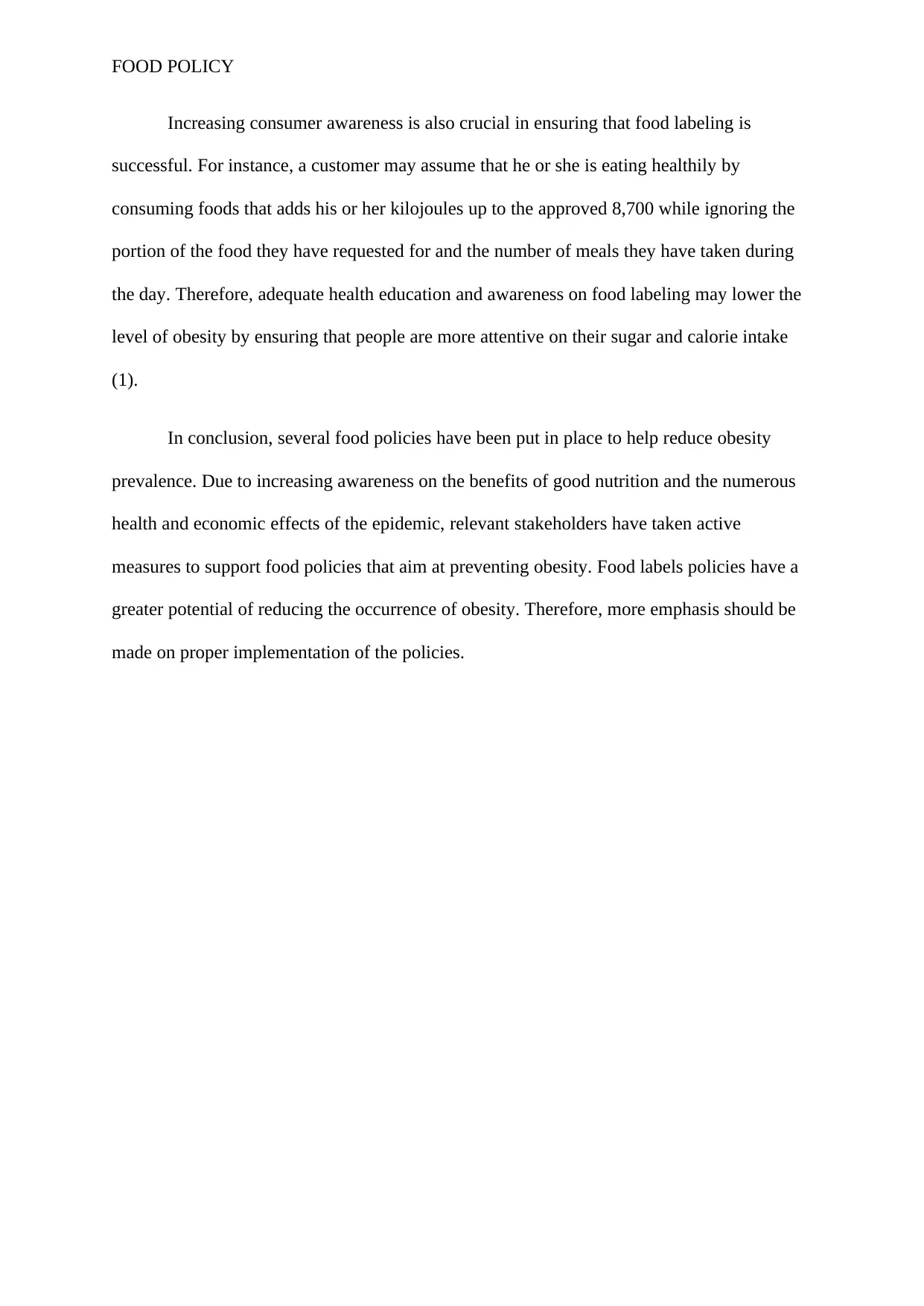
FOOD POLICY
Increasing consumer awareness is also crucial in ensuring that food labeling is
successful. For instance, a customer may assume that he or she is eating healthily by
consuming foods that adds his or her kilojoules up to the approved 8,700 while ignoring the
portion of the food they have requested for and the number of meals they have taken during
the day. Therefore, adequate health education and awareness on food labeling may lower the
level of obesity by ensuring that people are more attentive on their sugar and calorie intake
(1).
In conclusion, several food policies have been put in place to help reduce obesity
prevalence. Due to increasing awareness on the benefits of good nutrition and the numerous
health and economic effects of the epidemic, relevant stakeholders have taken active
measures to support food policies that aim at preventing obesity. Food labels policies have a
greater potential of reducing the occurrence of obesity. Therefore, more emphasis should be
made on proper implementation of the policies.
Increasing consumer awareness is also crucial in ensuring that food labeling is
successful. For instance, a customer may assume that he or she is eating healthily by
consuming foods that adds his or her kilojoules up to the approved 8,700 while ignoring the
portion of the food they have requested for and the number of meals they have taken during
the day. Therefore, adequate health education and awareness on food labeling may lower the
level of obesity by ensuring that people are more attentive on their sugar and calorie intake
(1).
In conclusion, several food policies have been put in place to help reduce obesity
prevalence. Due to increasing awareness on the benefits of good nutrition and the numerous
health and economic effects of the epidemic, relevant stakeholders have taken active
measures to support food policies that aim at preventing obesity. Food labels policies have a
greater potential of reducing the occurrence of obesity. Therefore, more emphasis should be
made on proper implementation of the policies.
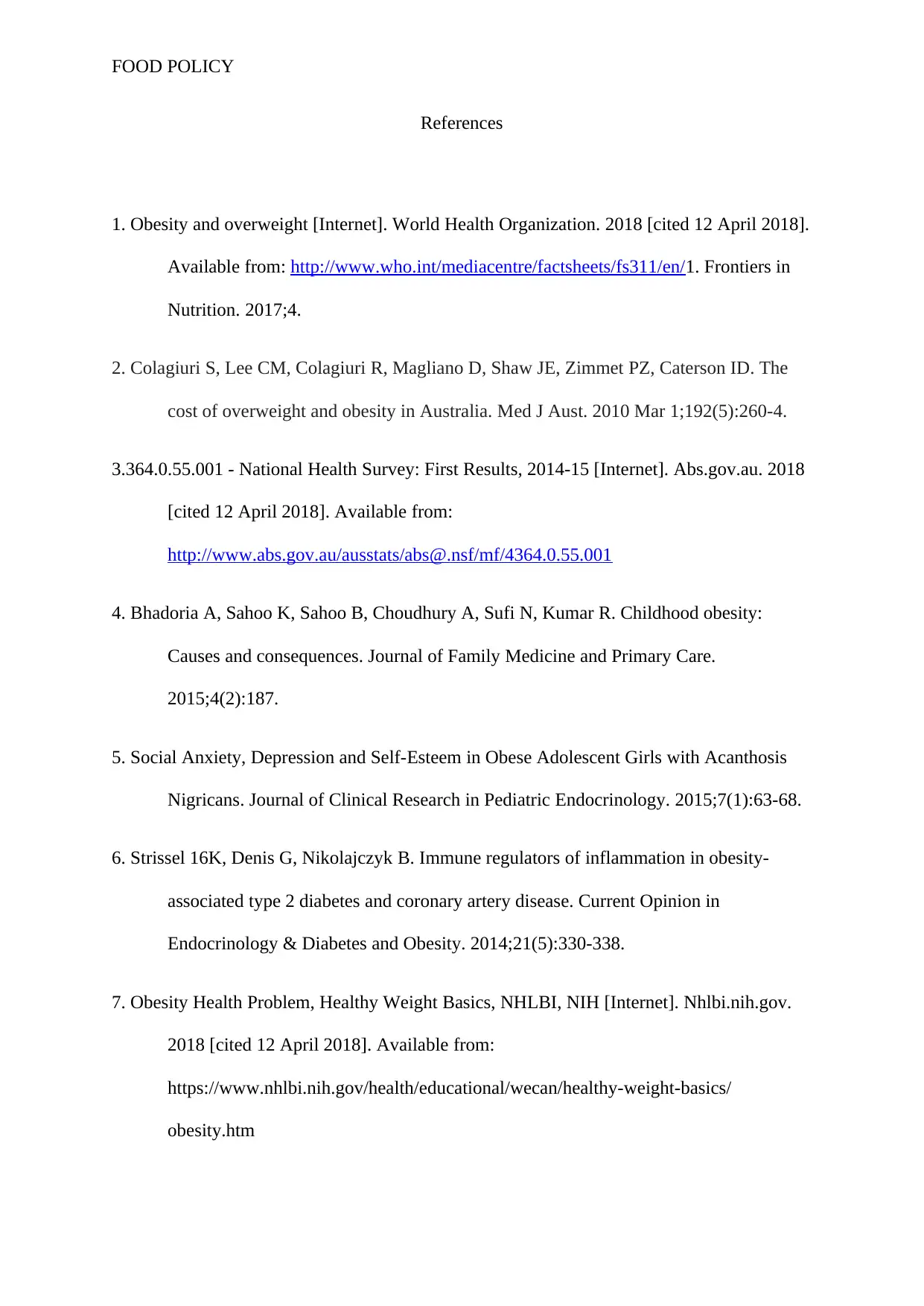
FOOD POLICY
References
1. Obesity and overweight [Internet]. World Health Organization. 2018 [cited 12 April 2018].
Available from: http://www.who.int/mediacentre/factsheets/fs311/en/1. Frontiers in
Nutrition. 2017;4.
2. Colagiuri S, Lee CM, Colagiuri R, Magliano D, Shaw JE, Zimmet PZ, Caterson ID. The
cost of overweight and obesity in Australia. Med J Aust. 2010 Mar 1;192(5):260-4.
3.364.0.55.001 - National Health Survey: First Results, 2014-15 [Internet]. Abs.gov.au. 2018
[cited 12 April 2018]. Available from:
http://www.abs.gov.au/ausstats/abs@.nsf/mf/4364.0.55.001
4. Bhadoria A, Sahoo K, Sahoo B, Choudhury A, Sufi N, Kumar R. Childhood obesity:
Causes and consequences. Journal of Family Medicine and Primary Care.
2015;4(2):187.
5. Social Anxiety, Depression and Self-Esteem in Obese Adolescent Girls with Acanthosis
Nigricans. Journal of Clinical Research in Pediatric Endocrinology. 2015;7(1):63-68.
6. Strissel 16K, Denis G, Nikolajczyk B. Immune regulators of inflammation in obesity-
associated type 2 diabetes and coronary artery disease. Current Opinion in
Endocrinology & Diabetes and Obesity. 2014;21(5):330-338.
7. Obesity Health Problem, Healthy Weight Basics, NHLBI, NIH [Internet]. Nhlbi.nih.gov.
2018 [cited 12 April 2018]. Available from:
https://www.nhlbi.nih.gov/health/educational/wecan/healthy-weight-basics/
obesity.htm
References
1. Obesity and overweight [Internet]. World Health Organization. 2018 [cited 12 April 2018].
Available from: http://www.who.int/mediacentre/factsheets/fs311/en/1. Frontiers in
Nutrition. 2017;4.
2. Colagiuri S, Lee CM, Colagiuri R, Magliano D, Shaw JE, Zimmet PZ, Caterson ID. The
cost of overweight and obesity in Australia. Med J Aust. 2010 Mar 1;192(5):260-4.
3.364.0.55.001 - National Health Survey: First Results, 2014-15 [Internet]. Abs.gov.au. 2018
[cited 12 April 2018]. Available from:
http://www.abs.gov.au/ausstats/abs@.nsf/mf/4364.0.55.001
4. Bhadoria A, Sahoo K, Sahoo B, Choudhury A, Sufi N, Kumar R. Childhood obesity:
Causes and consequences. Journal of Family Medicine and Primary Care.
2015;4(2):187.
5. Social Anxiety, Depression and Self-Esteem in Obese Adolescent Girls with Acanthosis
Nigricans. Journal of Clinical Research in Pediatric Endocrinology. 2015;7(1):63-68.
6. Strissel 16K, Denis G, Nikolajczyk B. Immune regulators of inflammation in obesity-
associated type 2 diabetes and coronary artery disease. Current Opinion in
Endocrinology & Diabetes and Obesity. 2014;21(5):330-338.
7. Obesity Health Problem, Healthy Weight Basics, NHLBI, NIH [Internet]. Nhlbi.nih.gov.
2018 [cited 12 April 2018]. Available from:
https://www.nhlbi.nih.gov/health/educational/wecan/healthy-weight-basics/
obesity.htm
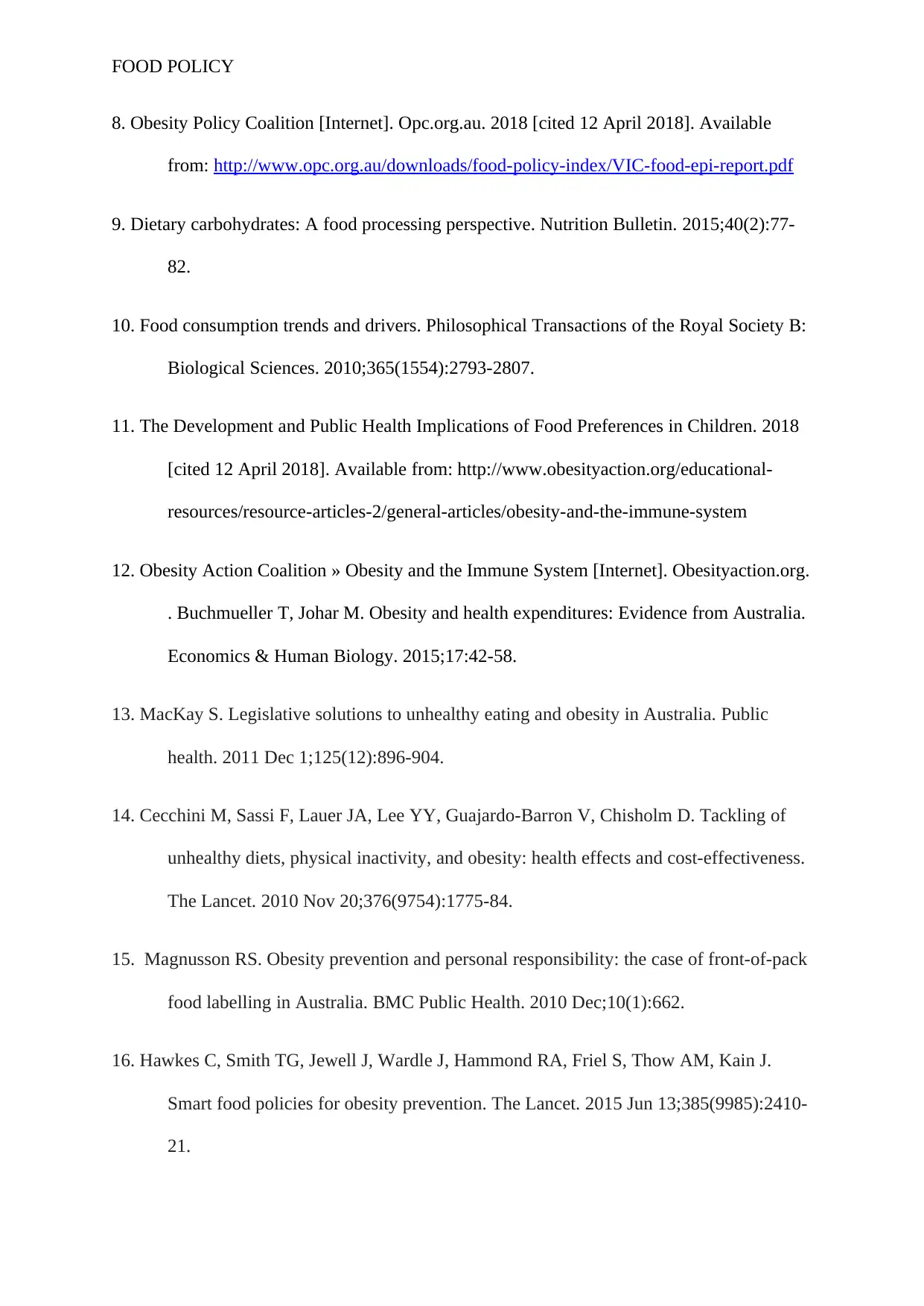
FOOD POLICY
8. Obesity Policy Coalition [Internet]. Opc.org.au. 2018 [cited 12 April 2018]. Available
from: http://www.opc.org.au/downloads/food-policy-index/VIC-food-epi-report.pdf
9. Dietary carbohydrates: A food processing perspective. Nutrition Bulletin. 2015;40(2):77-
82.
10. Food consumption trends and drivers. Philosophical Transactions of the Royal Society B:
Biological Sciences. 2010;365(1554):2793-2807.
11. The Development and Public Health Implications of Food Preferences in Children. 2018
[cited 12 April 2018]. Available from: http://www.obesityaction.org/educational-
resources/resource-articles-2/general-articles/obesity-and-the-immune-system
12. Obesity Action Coalition » Obesity and the Immune System [Internet]. Obesityaction.org.
. Buchmueller T, Johar M. Obesity and health expenditures: Evidence from Australia.
Economics & Human Biology. 2015;17:42-58.
13. MacKay S. Legislative solutions to unhealthy eating and obesity in Australia. Public
health. 2011 Dec 1;125(12):896-904.
14. Cecchini M, Sassi F, Lauer JA, Lee YY, Guajardo-Barron V, Chisholm D. Tackling of
unhealthy diets, physical inactivity, and obesity: health effects and cost-effectiveness.
The Lancet. 2010 Nov 20;376(9754):1775-84.
15. Magnusson RS. Obesity prevention and personal responsibility: the case of front-of-pack
food labelling in Australia. BMC Public Health. 2010 Dec;10(1):662.
16. Hawkes C, Smith TG, Jewell J, Wardle J, Hammond RA, Friel S, Thow AM, Kain J.
Smart food policies for obesity prevention. The Lancet. 2015 Jun 13;385(9985):2410-
21.
8. Obesity Policy Coalition [Internet]. Opc.org.au. 2018 [cited 12 April 2018]. Available
from: http://www.opc.org.au/downloads/food-policy-index/VIC-food-epi-report.pdf
9. Dietary carbohydrates: A food processing perspective. Nutrition Bulletin. 2015;40(2):77-
82.
10. Food consumption trends and drivers. Philosophical Transactions of the Royal Society B:
Biological Sciences. 2010;365(1554):2793-2807.
11. The Development and Public Health Implications of Food Preferences in Children. 2018
[cited 12 April 2018]. Available from: http://www.obesityaction.org/educational-
resources/resource-articles-2/general-articles/obesity-and-the-immune-system
12. Obesity Action Coalition » Obesity and the Immune System [Internet]. Obesityaction.org.
. Buchmueller T, Johar M. Obesity and health expenditures: Evidence from Australia.
Economics & Human Biology. 2015;17:42-58.
13. MacKay S. Legislative solutions to unhealthy eating and obesity in Australia. Public
health. 2011 Dec 1;125(12):896-904.
14. Cecchini M, Sassi F, Lauer JA, Lee YY, Guajardo-Barron V, Chisholm D. Tackling of
unhealthy diets, physical inactivity, and obesity: health effects and cost-effectiveness.
The Lancet. 2010 Nov 20;376(9754):1775-84.
15. Magnusson RS. Obesity prevention and personal responsibility: the case of front-of-pack
food labelling in Australia. BMC Public Health. 2010 Dec;10(1):662.
16. Hawkes C, Smith TG, Jewell J, Wardle J, Hammond RA, Friel S, Thow AM, Kain J.
Smart food policies for obesity prevention. The Lancet. 2015 Jun 13;385(9985):2410-
21.
Secure Best Marks with AI Grader
Need help grading? Try our AI Grader for instant feedback on your assignments.

FOOD POLICY
1 out of 11
Related Documents
Your All-in-One AI-Powered Toolkit for Academic Success.
+13062052269
info@desklib.com
Available 24*7 on WhatsApp / Email
![[object Object]](/_next/static/media/star-bottom.7253800d.svg)
Unlock your academic potential
© 2024 | Zucol Services PVT LTD | All rights reserved.





